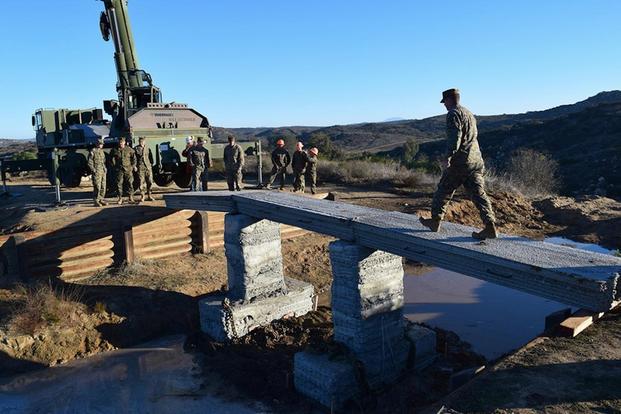A team of logistic Marines has printed a functional concrete footbridge without having to mix gravel and other heavy materials at the build site.
Members of 1st Marine Logistics Group made history last month when they completed the first 3D-printed bridge in the U.S., according to a Marine Corps news release.
The Marines built the bridge during Exercise Steel Knight in California, using a special printer developed by the Army and other partners. The printer can create structures on demand, cutting construction time from five days down to one.
The Marines also used a special concrete mixer for the bridge materials, a job that would normally require six people.
"Ultimately, we want one person standing there who hits 'print,' and the machine does all the work," said Capt. Matthew Friedell, a project officer who works with the printer. "We're getting there."
The Marines worked alongside members of the Army Corps of Engineers, who tested the bridge's load-bearing capabilities. Additional information about those capabilities, the bridge's size and the time it took to assemble were not immediately available.
Marine Corps leaders have big plans for incorporating 3D-printed materials into their operations. The service has fielded more than 160 3D printers in the last three years, according to new Marine Corps-wide guidance on the technology. They're being used in ground units and aviation squadrons to print structures and replacement parts.
Last summer, Marines, soldiers and Navy Seabees printed a 500-square-foot concrete barracks room in 40 hours. Marines also recently deployed to the Middle East with the first metal 3D printer.
In 2016, an MV-22B Osprey tiltrotor aircraft took to the skies with a 3D-printed part. And Marines with Combat Logistics Battalion 8 have also tested ways to use 3D printers during experiments meant to improve troops' survivability in austere combat environments where access to robust supply chains is not possible.
The ability to print bridges and other structures could also prove useful during humanitarian operations, Friedell said in the release.
"I see us going in and building things that help communities ... and possibly leaving the equipment there so they can keep building," he said.
Editor's note: This story has been updated to clarify that the printer was developed by the Army and other partners.
-- Gina Harkins can be reached at gina.harkins@military.com. Follow her on Twitter @ginaaharkins.










